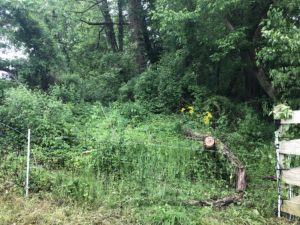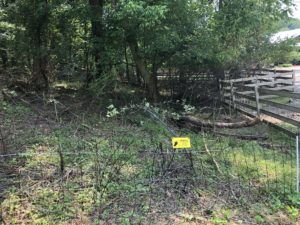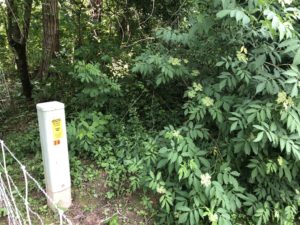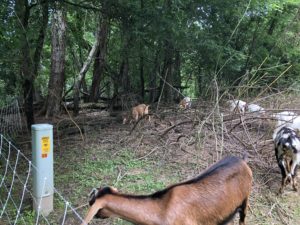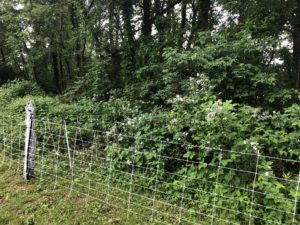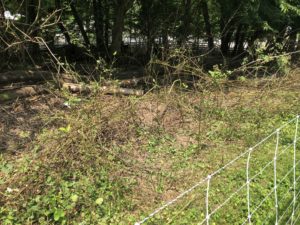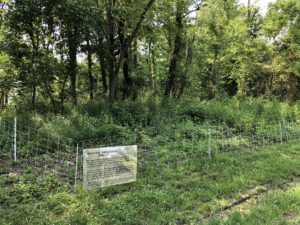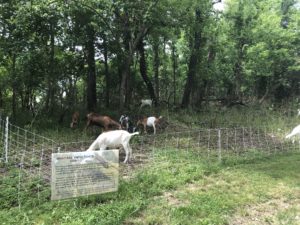Final report for FNC19-1168
Project Information
Before receiving the grant, invasive species on the project site were not being managed at all.
Landowners in Indiana face limited options regarding invasive plants treatments. The labor-intensive, expensive, or damaging effects of mechanical or hand removal often leave people turning to chemical treatment or quite simply, doing nothing at all to eradicate invasive species. Luckily there is a better option- goats! Several companies across the country successfully operate targeted grazing businesses. Unfortunately, those companies don't serve Indiana and there is not information available as to how these businesses are successfully operating.
If native species are to be preserved, targeted grazing must be an option for landowners everywhere. This means business information must be shared and easily replicated to encourage others to provide a targeted grazing service in their area. By conducting a targeted grazing plan, examining the state-specific results, and tracking business information (startup/operating cost, client base identification, marketing information, and troubleshooting industry specific issues), this project will lay the foundation for a targeted grazing company that could be easily replicated by others. As a result of this project, farmers could offer grazing services for increased revenue, landowners would have an ecologically sound option for invasive plant eradication, and a platform for invasive plant education would be created.
- Determine if a targeted grazing business model can be easily-replicated in other areas using information gathered from clients and potential clients.
- Conduct state-specific targeted grazing research at Bradford Woods, specifically monitoring the quanitity of invasive plant species both pre and post-grazing.
- Share findings through field days and educational signage at the test site.
Research
In order to create a targeted grazing service business model that is easily replicated, I am going to start a grazing business and keep track of start up costs, operating costs, and all equipment necessary. I am going to gather information on new clients to better understand any trends in client location/land type, and marketing information. I will also record and address the problems/solutions to any industry specific issues that arise. The field days will be informational, but also serve as a platform to survey the general public to further determine service demands/potential client trends, and understand what clients are willing to pay for the service (see attached survey Field-Day-Survey).
During this project, the area of the test site at Bradford Woods will be 1.3 acres. I intentionally did not want a test site larger than 1.5 acres because I only wanted 10 goats or fewer on the site. Based on my previous research, I did not think an area larger than 1.5 acres would be adequately grazed by 10 goats in a short period of time. I also do not want to transport more than 10 goats at a time based on trailer space. I am expecting the goats to completely defoliate all plant material in the 1.3 acre plot in about 6 weeks. The results of the test grazing will be a baseline and can be multiplied or divided to get a clear picture and answer the question "how many goats will clear how many acres in how many weeks?". The research being performed on invasive plants with the assistance of an arborist will be useful in marketing to state or local groups interested in eradicating invasive plants in specific areas.
*Initially the research was going to be conducted with 10 goats, but due to medical issues, 3 of the goats had to stay on the farm in quarantine for the first part of the project, but were added in later.
The project site was 1.27 acres and grazing took place within 4 different plots for ease of setting up fence and for concentrating goats into a smaller space to encourage concentrated grazing. Each plot was rated for density of vegetation to give an idea of plant coverage. In this case "moderately dense vegetation" means that one could visually see through the vegetation, but could not comfortably walk through the plot without manual removal of plants due to plant cover. "Highly dense vegetation" refers to a plot where visibility is very low and navigating through the plot was difficult without removal of plants. "Very highly dense vegetation" refers to the plot appearing to be a solid wall of vegetation that can not be seen into or walked through without cutting a walking path.
Within each of the four plots, six 6ftx6ft plant sampling sites were set up in a grid pattern to track changes in plants over time. Plots 1 and 2 were grazed a second time, simultaneously, after all four plots had been grazed once. This was done to determine if multiple grazing events in one season prove more beneficial than one grazing event per season. The term "cleared" refers to complete defoliation of all plants in the area.
2019
Plot 1 (0.55 acre, moderately dense vegetation): 7 goats cleared the plot in 16 days
Plot 2 (0.24 acre, highly dense vegetation): 7 goats cleared the plot in 11 days
Plot 3 (0.3 acre, very highly dense vegetation): 7 goats cleared the plot in 20 days
Plot 4 (0.18 acre, Extremely dense vegetation): 10 goats cleared the plot in 9 days
Plot 1 and 2 together, second grazing (0.79 acre, lightly dense vegetation): 10 goats cleared the plot in 8 days
All vegetation was reduced by 90-95% immediately following targeted grazing.
2020
The vegetation visually appeared much thinner and sparse compared to the previous year. Plots were the same as in 2019. The same goats were used, but a contributing factor to grazing progress could be the size and age of the goats. They are nearly full grown in 2020 and have a slightly higher grazing capacity compared to 2019, when some of them were adolescent.
Plot 1: 10 goats cleared the plot in 6 days
Plot 2: 10 goats cleared the plot in 5 days
Plot 3: 10 goats cleared the plot in 11 days
Plot 4:: 10 goats cleared the plot in 4 days
Plot 1 and 2 (a second time): 10 goats cleared the plot a second time in 3 days
Results:
On average, Multiflora Rose and Japanese Honeysuckle plants were reduced in size in a range of 12-15% throughout the plots. The goats appeared to browse on the tips of the branches and girdled the trunks of the plants in some instances, stunting the growth and reducing the size of the plant. It is estimated that continued browsing would continue to weaken and reduce the plant each time goats browse the area. The wild blackberry (brambles) were reduced in size by 15-20% in most areas. Again, the goats ate the tips of the branches and repeatedly weakened the plant via defoliation. We found it incredibly difficult to measure changes in grapevine and poison ivy. While the goats enjoyed eating the leaves, the vines were left intact. These vines were far too large and tall to measure any vertical growth. Measuring changes from the ground proved to be difficult, but we do know that goats completely defoliated the leaves of these plants, which has the potential to damage the plant over repeat grazing events. The Garlic Mustard actually was able to increase in population by 15-20%. This is most likely due to timing of grazing. We grazed goats in the early Summer and garlic mustard sets seed in Spring. If Garlic Mustard is to be targeted, goats would need to graze it before it sets seed.
Based on the information gathered from plots 1 and 2 (the plots that were grazed twice each year), multiple grazings in one season could be a beneficial method of reducing plant size in a quicker time frame, specifically Multiflora Rose, Japanese Honeysuckle, and Blackberry (bramble). These species were reduced in size up to 25% in some areas, compared to the 12%-15% range that we saw in plots that were only grazed once in the season.
We certainly saw promising results- decrease in plant size of woody invasive plants after one grazing. However, this is a project that really needs to be conducted long term (4-5 years). The short term benefits proved to be exciting and beneficial for both the control of spread and reduction of woody shrubs, but only a longer study could confirm if goats are capable of eradication of these species.
Based on these results, goats could be a useful first step in manual invasive species control. They allow dense areas to be navigated with ease after they graze an area if human intervention were to follow the efforts of the goats. Goats also proved to have the ability to navigate steep terrain (plot 2 and 3 were not accessible via mower), so could be useful a method in areas such as on earthen dams or steep slopes.
The financial investment for targeted grazing was higher than expected. Someone starting a goat grazing business should plan on investing $15,000- $20,000 in the first two years. The obvious expenses include a truck, livestock trailer, goats, portable fencing/solar chargers, vet care and medical equipment, and hay costs for supplementing or feeding goats over the winter months as needed. Other expenses should be factored in like marketing, business insurance (which proved difficult to find), employees/labor costs, and any shelter or permanent fencing necessary to use when goats are in the off season. Costs can vary depending on how experienced a goat owner may be and management plans (i.e. DIY vet care at times, not overwintering a large herd, etc.).
Through the field day surveys and dialogue, there appears to be a market and growing interest in this service and industry, especially from landowners looking for help managing small, wooded lots (under 2 acres). 75% of field day survey participants said they would be interested in the service on their own property, but it seemed folks didn't know what to expect in terms of pricing. 60% of people indicated they didn't have any idea what they would pay for the service. 30% of participants expected to pay $500 or more for the service, and 10% of people expected to pay under $500 for the service. Obviously, pricing should be set considering many factors like area to be grazed and labor costs.
Educational & Outreach Activities
Participation Summary:
The 2019 field day was a community education day conducted at the project site, Bradford Woods. The event was hosted both by me and the arborist Andrew Norman, hired to assist with the project. The purpose of the event was to educate attendees on the topic of targeted grazing and showcase the SARE project being conducted on site. Social media and news (print and television) were used to alert the public of this event. Estimated attendance was approximately 75 people, including members made up of conservation professionals, students, and landowners. Two professionals from the Morgan County Soil and Water Conservation District were present to provide educational tools and resources to landowners wanting information on local invasive species eradication. Not expecting a crowd of this size, a formal presentation was not scheduled and the event was set up in an open house structure where attendees could chat with me about the project, discuss details of the project with the arborist, learn about local resources from the MCSWCD professionals on site, and walk the project site and see the goats, equipment, and project process. Four attendees of the event would later call to either conduct a phone or on site consultation for goat grazing on their own property.
https://fox59.com/2019/08/20/local-farmer-studies-grazing-goats-to-manage-invasive-species/
The 2020 in person events were canceled due to the ongoing pandemic. I has such a wonderfully, unexpected interest in the project in 2019 and was determined to put on a better program for 2020, so I was disappointed to have to cancel. Instead, I sent out an email update to folks who's information I collected at last year's event about the continuation of the project and encouraged them to spread the word and send folks my way if they would like to learn more. Bradford Woods featured the project on their social media platform (thousand of followers), and I continued to hang informational signage at the project site for an passersby to read. It did not gain the attention of the the 2019 event, but I did have several folks reach out to me with interest in learning more about the project. It even led me to a meeting and conversation with the Brown County Soil and Water Conservation District about how (and if) goat grazing could be a viable management plan for landowners in the county in the future. It is still up for debate and we are continuing the conversation today.
Learning Outcomes
2019- As the project is only halfway completed at this time, I don't want to give any conclusive reports. At this point goats have proved to do a great job completely defoliating invasive species and reducing height of invasive plants, though we did observe re-sprout of said plants later on in the project. We will have more conclusive results in the Spring regarding plant regrowth, but it appears multiple season and repeated grazings are necessary to achieve plant eradication.
2020- Though goats appear to be a useful tool on steep terrain or heavily invasive plant infested areas, one must be strategic when using goats as a tool to fight invasive species. Goats are nondescript eaters and also have the potential to damage desirable plants, so care must be taken in certain locations to protect those plant species. One single grazing event could be used to visually and physically open up the area and make other methods of eradication feasible. Two years of grazing further weakened and reduces targeted plant's size. Multiple grazing events within one season proved an even more effective method than once per season. Several years of targeted grazing events will be required to significantly reduce targeted plant species. A continued study would be required to determine the timeline or feasibility of complete species eradication.
It seems getting the right stocking density to maximize efficiency and minimize unnecessary plant damage in important If you give goats too much space, they will take a long time to clear. If you don't give them enough space, they will strip bark and start to damage plants you may want to preserve. I found it important to not let goats get hungry, as they are a bit more willing to test the electric fence. Over the course of the study, I observed that 10 adult goats could clear 0.25 acres in 3-5 days consistently and with comfort. Young goats will eat significantly less and take some time to learn how to browse. Goats do appear to have differences in tastes and preference, but Multiflora Rose was consistently the first plant to be browsed on. Particular attention should be paid to when different plant species set seeds. Allowing goats to graze before seed set is probably ideal to mitigate spread. It is important to know which plants are being targeted so you can create a properly timed plan!
Experience with goats should be a prerequisite for someone considering managing a targeted grazing business, but for me, the most challenging part of the grant project and research was not anything to do with the goats, it was marketing and finding the right customer base. It's easy to find folks that like the idea of the service and would love to implement goat grazing on their land, though allowing folks to see the ecological value in the service and be able to pay a fair wage to the farmer for the work and not just the "fun" of goats was the barrier to get past.
Project Outcomes
While not a planned part of the grant project, through learning and networking as part of this research process, I learned of a program offered by Goats On The Go, a targeted grazing company who offers an affiliate program to those interested in operating their own targeted grazing businesses. This is a program others should look into if interested in replicating a targeted grazing business in their area.
It would have been valuable to track grazing impact on native plants, but the unfortunately the focus of this project was invasive plants. Though data was not collected, observations revealed native plants had similar results in that multiple grazing events would need to take place to do permanent damage to the plant. Further research could be done to determine how targeted grazing could be applied to more "sensitive" areas where invasive species are needing to be controlled.
